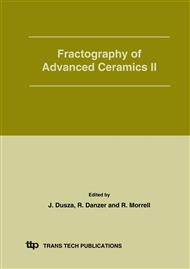p.1
p.14
p.23
p.31
p.39
p.46
p.54
p.62
p.70
Edge Flaking - Similarity between Quasistatic Indentation and Impact Mechanisms for Brittle Materials
Abstract:
The process of edge flaking of brittle materials is a significant limitation in design, handling and use of components. Simple quasistatic tests to identify resistance to edge flaking can be based on near-edge indentation and scratching towards an edge, and these produce rankings of materials that broadly correlate with GIc or KIc. However, most edge damage occurs in practice by impact. Using a drop-weight impact tester, edge chipping tests have been performed dynamically on a range of brittle materials, using repeated impact with step-wise height increments until fracture. It has been found that when impact energy rather indentation force is used as the correlative parameter against distance of the impact site from the edge of the test-piece, a similar relationship to that of quasistatic indentation is found. The shapes of edge flakes produced may also similar. This suggests that even when a relatively blunt impactor is used, compared with conventional indenters, the mechanics of the failure are similar. However, the occurrence of ring cracks can lead to unusual flake shapes. It follows that simpler-to-perform quasistatic tests can model the less well-defined dynamic impact situation in terms of testing for the effects of geometry or for comparing performance of different material types.
Info:
Periodical:
Pages:
14-22
Citation:
Online since:
July 2005
Authors:
Keywords:
Price:
Сopyright:
© 2005 Trans Tech Publications Ltd. All Rights Reserved
Share:
Citation:


